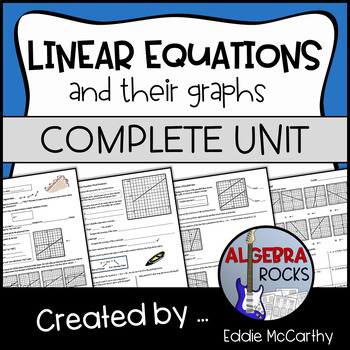Linear Equations Unit (Graphs) - Graphing Linear Functions Guided Notes & HWs
Eddie McCarthy
1.2k Followers
Resource Type
Standards
CCSS8.EE.B.6
CCSS8.F.A.3
CCSSHSA-CED.A.2
CCSSHSA-CED.A.4
CCSSHSF-IF.B.4
Formats Included
- Zip
Pages
48 pages
Eddie McCarthy
1.2k Followers
What educators are saying
I am currently working with a team of teachers to supplement our Linear Equations unit. This was a very good resource for us to supplement what we are currently doing.
So nice to have this a part of my resources. It makes my life so much easier here at the begin of the school year.
Description
For details, click the links below! This unit bundle contains:
1) Slope * FREE! *
4) Converting to Slope-Intercept Form
5) Writing Linear Equations (2 days)
6) Linear Equations: Applications & Word Problems (2 days)
7) Intercepts
8) Parallel & Perpendicular Lines (2 days)
Total Pages
48 pages
Answer Key
Included
Teaching Duration
2 Weeks
Report this resource to TPT
Reported resources will be reviewed by our team. Report this resource to let us know if this resource violates TPT’s content guidelines.
Standards
to see state-specific standards (only available in the US).
CCSS8.EE.B.6
Use similar triangles to explain why the slope m is the same between any two distinct points on a non-vertical line in the coordinate plane; derive the equation 𝘺 = 𝘮𝘹 for a line through the origin and the equation 𝘺 = 𝘮𝘹 + 𝘣 for a line intercepting the vertical axis at 𝘣.
CCSS8.F.A.3
Interpret the equation 𝘺 = 𝘮𝘹 + 𝘣 as defining a linear function, whose graph is a straight line; give examples of functions that are not linear. For example, the function 𝘈 = 𝑠² giving the area of a square as a function of its side length is not linear because its graph contains the points (1,1), (2,4) and (3,9), which are not on a straight line.
CCSSHSA-CED.A.2
Create equations in two or more variables to represent relationships between quantities; graph equations on coordinate axes with labels and scales.
CCSSHSA-CED.A.4
Rearrange formulas to highlight a quantity of interest, using the same reasoning as in solving equations. For example, rearrange Ohm’s law 𝘝 = 𝘭𝘙 to highlight resistance 𝘙.
CCSSHSF-IF.B.4
For a function that models a relationship between two quantities, interpret key features of graphs and tables in terms of the quantities, and sketch graphs showing key features given a verbal description of the relationship.





